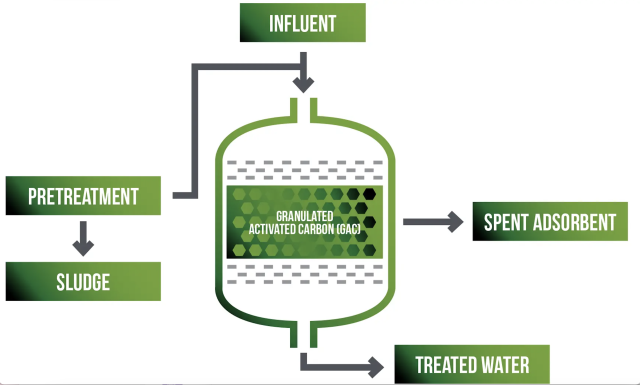Granular Activated Carbon to Treat PFAS in Water

The spread of per and polyfluoroalkyl substances (PFAS) into soil and water has led to the increased concern of the chemical’s effects on human health and the environment. This global unease has led to an environmental imperative to develop long-term solutions to treat, dispose or destroy PFAS.
Clean Earth’s ReSolve program has tested a range of solutions to address PFAS. Currently. Clean Earth deploys Granular Activated Carbon (GAC) as a solution to treat PFAS-contaminated water. ReSolve’s GAC technology is deployed at Clean Earth’s facility in Detroit, Michigan.
The technology behind GAC uses carbon for its natural adsorbent properties, which when treating water, can adsorb PFAS from the waste matrix leaving behind filtered water. Typically applied in a fixed bed, GAC can be composed of readily available non-toxic properties, like granules of coal, peat, wood, or coconut shells, and has the essential characteristic of being a porous structure. Pores are important when determining how to remediate toxins such as PFAS.
The process begins as contaminated water flows through the GAC and adsorbs to the surface. The pores generate a large surface area that binds and captures the PFAS compounds, resulting in treated water. Sometimes, the water requires an additional pump through columns or tanks to remove other contaminants. Following the removal process, the water is tested to guarantee the desired cleanup level is met.
As contaminants eventually take up pores and can no longer function as a host for adsorption, the GAC is considered ‘spent.’ The spent GAC may be replaced with virgin or regenerated carbon. To illustrate ReSolve’s commitment to sustainable PFAS solutions, Clean Earth opts to use a carbon regeneration process.
The ReSolve program hosts a toolbox of innovations offering prominent environmental solutions for hazardous waste remediation. Armed with knowledge, ReSolve stands at the forefront of tackling contaminated water. In addition to GAC, ReSolve continues with a dedicated team of experts who are actively developing diverse strategies to help diminish the risk of PFAS, aiming to guide its customers into a position of understanding and acting.
The information, content and materials provided on this website and its incorporated related links (“Content”) does not, and is not intended to, constitute legal advice, nor is it prepared by lawyer or law firm or as the product of any attorney-client relationship. Content is provided "as is;" no representations are made that the content is error-free. Content is available for general informational purposes only and may not constitute the most current legal or other information. Recipients and viewers of the Content assume all responsibility and risk arising from its use and reliance upon the Content and should contact an attorney to obtain advice before acting or refraining to act on the Content. All liability with respect to actions taken or not taken based on the Contents is hereby expressly disclaimed.

